Students get through the MP Board Class 11th Biology Important Questions Chapter 17 Breathing and Exchange of Gases which are most likely to be asked in the exam.
MP Board Class 11th Biology Important Questions Chapter 17 Breathing and Exchange of Gases
Breathing and Exchange of Gases Class 11 Important Questions Very Short Answer Type
Question 1.
How smoking affects the process of respiration ?
Answer:
Regular smoking resulting in the deposition of tar of smoke on the walls of trachea. Due to which their cells are always irritated and resulting cough. The cells of respiratory organs are irritated due to substances of smoke which produces cancer in neck, mouth and lungs. This smoke is also collected in the air chambers of lungs which reduces their volume and resulting congestion.
Question 2.
What is Vital capacity ? Give its importance. (NCERT)
Answer:
Volume of air which can be maximally inspired and also maximally expired by the lungs is termed as Vital capacity.
In males, it is about 4500 ml while in females, it is about 3000 ml. (The vital capacity of the lungs in mountain dwellers and athletes is always high in comparison to others.)
Importance: On the basis of vital capacity of the lungs of a patient defect or disease of the lungs can be diagnosed by the doctors.
![]()
Question 3.
Name the condition of the body occurs due to deficiency of oxygen.
Answer:
Condition arises in the body due to deficiency of oxygen is called as Hypoxia. This condition arises due to height or deficiency of air pressure or due to cyanide poison or carbon monoxide.
Question 4.
What is Tidal volume? Determine Tidal value of a healthy adult person in one hour. (NCERT)
Answer:
Volume of the air inspired and expired by the lungs during effortless normal breathing in a healthy adult person is called as Tidal volume. It is about 500 ml in adult normal person. It increases during excitement and activity.
Tidal value of lungs in one breathing is 500 ml.
In one minute normal person respire 16 times and in one hour 16 x 60 times. Therefore, Tidal value of a healthy person in one hour is 500 mix 16 x 60 = 4,80,000 ml..
Question 5.
How does concentration of CO2 and dissociation of oxyhaemoglobin are related with each other ?
Answer:
Concentration of CO2 regulate the process of dissociation of oxyhaemoglobin. Both the processes are proportional to each other. Blood become acidic when CO2 concentration increases in the blood, as CO2 reacts with water to form carbonic acid (H2CO3).
CO2+H2O → H2CO3 Carbonic acid
Acidic medium of the blood stimulate dissociation of oxyhaemoglobin into oxygen
and haemoglobin.
Question 6.
Write differences between Respiration and Breathing.
Answer:
Differences between Respiration and Breathing
| Respiration | Breathing |
| 1. Respiration is a biochemical process in which food materials are oxidized by oxygen. | It is a physical process in which O2 is taken during inspiration and CO2 is released during expiration. |
| 2. ATP (energy) is released in this process. | ATP is not released in this process. |
| 3. This process is always intracellular. | It is an extracellular process. |
Question 7.
It is better to respire through nose than mouth. Why ?
Answer:
Respiration through nose is better because of the following reasons :
- It is a natural process.
- Air of the atmosphere contain dust particles, bacterias and other harmful substances, which are filtered by the hairs present in the nose wall.
- Turbinal bone of the nose heat the air, thus it acts as air conditioner.
Question 8.
Respiratory organs are not essential for protozoans ?
Answer:
Protozoans are unicellular animals like Amoeba, Paramoecium, Euglena. Gaseous exchange occurs through plasma membrane by diffusion process. Thus, respiratory organs are not essential for protozoans.
Question 9.
Write names of respiratory organs of leech and insect.
Answer:
Animals Respiratory organs
Leech – Skin
Insect – Trachea.
![]()
Question 10.
How much volume of the air is left in the lungs at the end of forcible expiration ? (NCERT)
Answer:
At the end of forcible expiration volume of the air left in the lungs is 1200 ml. It is called as residual volume.
Question 11.
Name the respiratory organs of the following ;
(1) Fish,
(2) Amphibians,
(3) Birds,
(4) Earthworm.
Answer:
| Organisms | Respiratory organs |
| (1) Fish | Gills |
| (2) Amphibians | Skin, lungs, buccal cavity |
| (3) Birds | Lungs and air sacs |
| (4) Earthworm | Skin. |
Breathing and Exchange of Gases Class 11 Important Questions Short Answer Type
Question 1.
What is the significance of intercostal muscles in expiration?
Answer:
Intercostal muscles on contraction reduce the volume of the thorax. Decrease in the volume of thorax will also cause the decrease in the volume of lungs. Thus air pressure is increased within lungs and air is passed out from the lungs. Thus intercostal muscles helps in the process of expiration.
Question 2.
What is Respiration? It is of how many types? Explain in brief.
Answer:
Respiration: Respiration is an oxidation reaction inside the cell in the presence of specific enzymes in which complex organic substances are oxidized to produce C02, H20, other organic substances and energy.
C6H12O6 +6O2 → 6H2O+ 6CO2 + 673 kcal energy or38ATP
It is of two types :
1. Anaerobic respiration: In this process, food materials are incompletely oxidized in the absence of 02 to produce C02 and simple organic substances like ethyl alcohol, citric acid, lactic acid, malic acid, butyric acid and oxalic acid. It is found in micro-organisms, bacteria, yeasts and some animal tissues.
C6H12O6 → 2C2H5OH +2C02 +21 kcal or 2ATP
2. Aerobic respiration: It is a respiration in which food materials are completely oxidized in the presence of 02 to produce C02, H20 and energy. It is found in plants and animals.
C6H12O6 +6O2 → 6CO2 + 6H2O+ 673kcal or38ATP
Question 3.
Describe the chemical nature and properties of haemoglobin.
Answer:
Red blood corpuscles contain a red pigment known as haemoglobin. Haemoglo¬bin possessing a specific protein known as globulin, in which iron is associated with homegroup. Haemoglobin is a micromolecule with imperial formula: C587 H1213 N195 O214 S3 Fe. Haemoglobin combine with oxygen and form oxyhaemoglobin. It is dissociated in tissues into O2 and haemoglobin and thus it plays an important role in the conduction of O2 in the cells.
![]()
Question 4.
Differentiate between external and internal respiration.
Answer:
Differences between external and internal respiration
| External Respiration | Internal Respiration |
| 1. It is a physical process. | It is both a physical as well as physiological process. |
| 2. It involves lungs, skin and other respiratory surfaces. | It involves every cell. |
| 3. 02 is absorbed and CO2 is released in this process. | Food is oxidized and CO2 is released in this process. |
| 4. It results in exchange of gases between inspired air and blood. | It results in the exchange of gases between living cells and the blood across the tissue fluid. |
Question 5.
What do you understand by chloride shift?
Answer:
Chloride shift: During respiration food materials are oxidized and releases CO2 and energy (ATP). Released CO2 is then transported into cells through tissue fluid. In tissues, this CO2 combines with water and forms carbonates in R.B.C. which increases their pH. To maintain electrical concentration balance bicarbonate ions (HCO–3) are diffused into
plasma and equal amount of Cl– ions are diffused into erythrocytes (R.B.C.). Thus, sodium bicarbonate is collected in the plasma and potassium chloride is collected in R.B.C. This whole process is termed as chloride shift.
Question 6.
Write differences between following :
(a) Tracheoles and Bronchioles,
(b) Carbamino haemoglobin and Oxyhaemoglobin.
Answer:
(a) Differences between Tracheoles and Bronchioles
| Tracheoles | Bronchioles |
| 1. In insects each trachea branches extensively to form tracheoles which ends intracellularly in the tissue cells. | In mammals each bronchi divides into bronchioles. |
| 2. Through tracheoles exchange of gases occurs between air and cell fluid. | Exchange of gases do not occur through bronchioles but air passes through it. |
(b) Differences between Carbamino haemoglobin and Oxyhaemoglobin
| 1. It is formed by combination of CO2 with amino-haemglobin. | It is formed by combination of oxygen with haemoglobin. |
| 2. CO2 is transported in this form through blood. | O2 is transported in this form through blood |
| 3. Carbamino haemoglobin is carried through blood towards the lungs. | Oxyhaemoglobin is carried through blood to all parts of the body. |
| 4. Blood containing carbamino haemoglobin is called as impure blood. | Blood containing oxyhaemoglobin is called as pure blood. |
Question 7.
What will be the salient features for any respiratory surface for gaseous exchange?
Answer:
The following are the characteristics for any respiratory surface :
- The surface must be thin and permeable,
- It must be moist so that gases may dissolve in it.
- The surface area must be vast so that more gaseous exchange may take place,
- It must be well-supplied with capillary network of blood,
- It must be always in contact with oxygen.
![]()
Question 8.
How the concentration of CO2 and dissociation of oxyhaemoglobin are related with each other?
Answer:
The concentration of CO2regulate the process of dissociation of oxyhaemoglobin. Both processes are proportional with each other. The blood becomes acidic when CO2 concentration is increased in blood because CO2 forms carbonic acid (CO2+H2O → H2O–3)when it combines with the water of blood plasma. Acidic medium of blood stimulates the dissociation of oxyhaemoglobin into oxygen and haemoglobin. Thus, it is dissociated into O2and haemoglobin.
Question 9.
Mitochondria is regarded as powerhouse of cells, why?
Answer:
Mitochondria is a cell organelle in which food materials are oxidized to form ATP (energy) which stores higher amount of energy. When energy is required then the dissociation of ATP takes place and a large amount of energy liberated, hence mitochondria is called as powerhouse of the cell.
Question 10.
Differentiate Aerobic and Anaerobic respiration.
Answer:
Differences between Aerobic and Anaerobic respiration
| Aerobic respiration | Anaerobic respiration |
| 1. Aerobic respiration requires oxygen takes place in cytoplasm and mitochondria. | It does not require oxygen and takes place in cytoplasm only. |
| 2. The substrate is completely oxidized. | The substrate is incompletely oxidized. |
| 3. End-products are CO2 and H2 | End-products are ethyl alcohol and CO2. |
| 4. 38 ATP (673 kcal) energy is produced. | 2 ATP (21 kcal) energy is produced. |
| 5. Harmful substances are not formed. | Harmful substance ethyl alcohol is forme. |
Question 11.
Write difference between Respiration and Combustion.
Answer:
Differences between Respiration and Combustion
| Respiration | Combustion |
| 1. It is a vital process | It is a physical process. |
| 2. Rate of oxidation is slow. | Rate of oxidation is faster. |
| 3. It is controlled process. | It is uncontrolled process. |
| 4. Energy is released in the form of ATP. | Energy is released in the form of light and heat. |
| 5. It is controlled process. | It is an uncontrolled process. |
Question 12.
What is oxygen debt?
Answer:
Oxygen debt: During strenuous work, the muscle does not get sufficient amount of oxygen to meet its energy needs immediately. Hence, it contracts anaerobically and accumulates lactic acid produced by anaerobic glycolysis. During recovery stage, the accumulated lactic acid is oxidized by utilizing oxygen in addition to the normal regular required manner. The extra oxygen consumed during recovery stage is called oxygen debt of the muscles. It is used in oxidizing lactic acid and in restoring the depleted creatine phosphate and ATP in the muscle fibre.
Question 13.
Why does muscles get tired while doing more work?
Answer:
While doing active or fast work, muscles need fast supply of energy, for which anaerobic oxidation of food occurs in the muscles to supply energy at fast rate. Accumulation of lactic acid occurs in the muscle due to this muscles become tired and stop functioning. This is called as Muscle fatigue. After taking rest for sometime lactic acid converts into pyruvic acid again and muscles become normal.
![]()
Question 14.
Define oxygen dissociation curve. (NCERT)
Answer:
Oxygen dissociation curve: It is a sigmoid or ‘S’ shaped curve which represents percentage of oxygen saturation in the haemoglobin due to pO2 pressure (partial). Sigmoid curve is formed due to saturation of haemoglobin.
Breathing and Exchange of Gases Class 11 Important Questions Long Answer Type
Question 1.
Explain the mechanism of CO2 transport through blood. (NCERT)
Answer:
Mechanism of transport of CO2 through blood: Respiraion is defined as “A biochemical catabolic process which involves stepwise degradation or oxidation of glucose in mitochondria, with the release of energy and formation of ATP, inside the living cell at body temperature”.
In our body the circulation of CO2 with blood takes place by the following methods :
1. Dissolved in plasma: The solubility of CO2 in blood is twenty times more than the solubility of O2 in blood.
But only 7% of the total C02 is transported through plasma. When CO2 comes in contact with plasma then it forms carbonic acid by the use of water of plasma. This carbonic acid is transported up to lungs and dissociated to release water and CO2 is transported into alveoli of the lungs.
CO2 +H2O ⇌ H2C03(Carbonic acid)
2. As carbamino compounds: About 30% of CO2 passing into erythrocytes, combine with haemoglobin to form a stable compound known as carbamino-haemoglobin. After reaching the alveolar surfaces these compounds release CO2 on it which is then diffused into alveoli.
HbNH2 +CO2 →HbNHCOOH (in tissue) (Carbamino compound)
3. As bicarbonates: Remaining 70% of CO2 is transported in the form of bicarbonates. Bicarbonates are formed by the reaction of C02 with the carbonates of sodium and potassium. These bicarbonates are transported by plasma or erythrocytes. After reaching alveoli these compounds release C02 on it which is then diffused into alveoli. Carbonic anhydrase enzyme catalyses this reaction.
In this way CO2 and is released from bicarbonate. At the same time oxygenation of haemoglobin simultaneously releases CO2. In this way CO2 is released in the lungs. This CO2 thus released, is forced out of the body through expiration.
H2O+ CO2 + Na2CO3 → 2NaHC03 (Sodium bicarbonate)
Question 2.
Describe any five diseases related to respiration along with two symptoms.
Or,
Describe some disorders of respiratory system.
Answer:
Some common disorders of respiratory system of human beings :
1.Asthma: It is a type of allergic reaction in which mucous of respiratory canal become dense and thus expiration is affected. This disease is generally caused due to pollen grains of flowers and some food substances.
2. Common cold: It is a viral disease in which swelling occurs in mucous membrane and secretion of mucous is also increased. Nose becomes closed and thus intake of oxygen is difficult.
3. Emphysema: It is the condition where the breaking up of the walls separating the alveoli occurs reducing the gas exchange area of the lungs.
4. Lung cancer: The disease is generally found in smokers. The lung tissues growing abnormally and ultimately resulting in the death of the suffering person.
5.Tuberculosis: It is a bacterial disease of lungs and is caused by Mycobacterium tuberculosis. These bacteria releasing tuberculin a toxin which causes fever, loss of weight and general weakness in the patient.
6. Pneumonia: It is also a bacterial disease, caused by Diplococcus pneumonia. The symptoms are accumulation of lymph and mucous in the alveoli and bronchioles. This seriously effects the breathing.
7. Pleurisy: The lungs are enveloped by a thin sheet of smooth epithelium called pleura. Sometimes this pleura gets inflamed because of certain reasons. The disease thus results is called pleurisy.
Question 3.
Explain the process of inspiration in normal condition. (NCERT)
Answer:
Breathing: Breathing or ventilation is the movement that brings in fresh air into the lungs for gaseous exchange and takes out the foul air from them. There are two types of muscles which play an important role in breathing movement.
- External intercostal muscles: A pair of these muscles arising from upper part of the ribs and is attached with the lower part of the backward rib.
- Internal intercostal muscles: A pair of these muscles arising from lower part of each rib which goes up to the upper part of the backward rib and joined with it.
Mechanism of breathing: The process of breathing involves in the following two processes:
1. Inspiration or Inhalation: Inspiration is a process in which air taken into the lungs. During inspiration the external
intercostal muscle contract, the front ends of the ribs move upward and outward. At the same time the radial muscles of diaphragm contracts making it somewhat straight. This whole process increases the volume of the airtight chest cavity. This lowers the partial pressure inside the lungs. To make up the pressure air enters from outside through trachea and its branches to the air sacs and alveoli of the lungs.
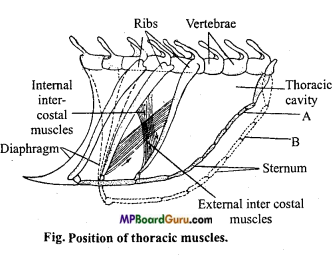
2. Expiration or Exhalation:
Expulsion of the air to the outside from the body is termed as expiration. In this process internal intercostal muscle contracts due to which ribs return to their normal position.
The diaphragm relax, becomes convex and the abdominal organs place in its original position. Consequently, the capacity of the chest cavity decreases. The lungs become compressed, the pressure in them rises with the result the air from the lungs rushes out through air passage. Both of these processes are repeated alternatively. During resting period a healthy person breaths 16-20 times per minute.
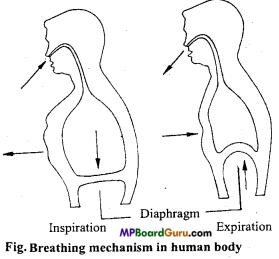
Question 4.
Write differences between following: (NCERT)
(a) IRV and ERV
(b) Inspiratory capacity (IC) and Expiratory capacity (EC)
(c) Vital capacity and Total lung capacity.
Answer:
(a) Differences between IRV and ERV
| Inspiratory reserve volume (IRV) | Expiratory reserve volume (ERV) |
| 1. It is the amount of air that can be inhaled forcefully by the lungs after normal inspiration. | It is the amount of air that can be exhaled out forcefully by the lungs after normal expiration. |
| 2. It is about 2500 ml in adult normal man and 1900 ml in normal woman. | It is about 1000 ml in adult normal man and 700 ml in normal woman. |
(b) Differences between Inspiratory capacity (IC) and Expiratory capacity (EC)
| Inspiratory capacity (IC) | Expiratory capacity (EC) |
| 1. It is the volume of air which can be maximally inspired. | It is the volume of air which can be maximally expired. |
| 2. Its value is equal to sum of Tidal volume and Inspiratory reserve volume (TV + IRV). | Its value is equal to sum of Tidal and Expiratory reserve volume (TV + ERV). |
| 3. In normal male its value is (500 + 3000) ml i.e. 3500ml whereas in normal female its value is (500 + 1900) ml i.e. 2400ml. | In normal male its value is (500 +1000) ml i.e. 1500ml whereas in normal female its value is (500 +700) ml i.e. 1200 ml. |
(c) Differences between Vital capacity and Total lung capacity
| Vital capacity | Total lung capacity |
| 1. Volume of air which can be maximally inspired and also maximally expired by the lungs in a normal healthy person is called as vital capacity. | It is the sum of Vital capacity and residual volume of the air in the lungs of a normal healthy person. |
| 2. In normal man, it is about 4500 (3000 + 500 + 1000) ml whereas in normal woman it is about 3100 (1900 + 500 + 700) ml. | In normal man, it is about 5700 (4500 +1200) ml whereas in normal woman it is about 4200 (3100+ 1100) ml. |
Question 5.
How is respiration process regulated? (NCERT)
Answer:
Regulation of Respiration: Normally, the rate of respiration is determined by both, nervous and chemical control.
1. Nervous control: Diaphragm and intercostal muscles are innervated by nerves from the central nervous system. Nerves are influenced by the respiratory centre located in medulla oblongata. Medulla oblongata consists of two parts inspiratory centre and expiratory centre, both the centres do not work together, i.e., when inspiratory centre is active, expiratory centre is inactive and when expiratory centre is active, inspiratory centre is inactive. This makes respiration rhythmic process, which is essential for effective gaseous exchange. In the pons, there is another centre called pneumotaxic centre which acts on the inspiratory centre and produces periodic inhibition. This inspiratory centre is said to be in a constant state of excitability and it sends impulses to inspiratory muscles resulting inspiration.
Pneumotaxic centre receives impulses from the inspiratory centre during inspiration which in turn transmits impulses to the expiratory centre. The expiratory centre is stimulated by the pneumotaxic centre.
Expiratory centre is connected to the vagus nerves, which innervates the lungs. During inspiration when lungs expand, stretch receptors present in the lung are stimulated and send impulses to the expiratory centre through vagus. Expiratory centre then sends inhibitory impulses to the inspiratory centre to stop inspiration. It is called Herring-Breuer reflex.
2. Chemical control: The main object of respiration is to maintain appropriate oxygen and carbon dioxide concentration and also hydrogen ion concentration in the blood. Pulmonary ventilation is highly sensitive to changes in oxygen, carbon dioxide and hydrogen ions. None of the three areas expiratory, inspiratory and pneumatic, are affected directly by changes in ion concentration of CO2 and hydrogen in blood. One more centre chemosensitive area is believed to be located bilaterally and ventrally in the medulla.
It lies in the area where glossopharyngeal and vagus nerves enter the medulla. This area is very sensitive to blood, C02 and hydrogen ion concentration and in turn, stimulates other parts of the respiratory system. The sensory neurons of the chemosensitive area are especially excited by hydrogen ions which provide direct stimulus for these neurons. However, hydrogen ions can not easily cross the blood-brain barrier or blood-cerebrospinal fluid barrier.
So, changes in H+ ions concentration have little effect in exciting the neurons of the chemosensitive area than do the changes in carbon dioxide. CO2 can cross blood-brain barrier easily. If there is increase in CO2 concentration in the blood, there also occurs increase in pCO2 both in the interstitial fluid of the medulla and the cerebrospinal fluid. In these fluids, CO2 reacts with water to form carbonic acid which dissociates to form hydrogen ions and bicarbonate ions. Thus, more hydrogen ions are there in the chemosensitive area of the respiratory centre when the blood CO2 increases. This stimulates the chemosensitive area thereby causing increased strength of both inspiratory and expiratory signals to the respiratory muscles.
Oxygen concentration in blood does not have a significant direct effect on the respiratory centre of the brain, which controls respiration. Special chemoreceptors located outside the central nervous system are responsive to changes in blood O2, CO2 and hydrogen ion concentration. These chemical receptors are located in the carotid and aortic bodies.
![]()
Question 6.
What is the affect of pCO2 on transport of oxygen? (NCERI)
Answer:
The gaseous exchange in the lungs depends on the difference between the oxygen and carbon dioxide pressures in the pulmonary alveoli and the venous blood flowing to the lungs. The partial pressure of oxygen (pO2) in the air sacs of lungs is higher than that of the lung capillaries, while the partial pressure of carbon dioxide (pCO2) in the lung capillaries is higher than that in air sacs. In this way oxygen passes from air into the blood and C02 from blood into air and exhaled.
In the inspired air, the partial pressure of oxygen (pO2) is normally 158 mm Hg, while that of carbon dioxide (pCO2) is 0.3 mmHg.
The lungs and alveoli already contain some air even after expiration and so this air contains \more carbon dioxide and less oxygen in comparison to inspired air. Thus, when this air mixes Vith inspired air, the partial pressure of oxygen comes down to 100 mm Hg and that of CO2 increases to 40 mm Hg.
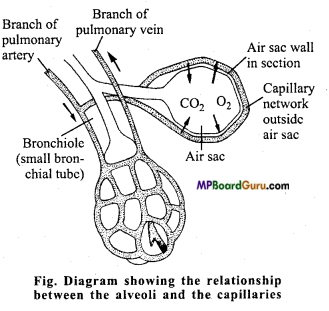
The pulmonary artery contains deoxygenated blood in which partial pressure of oxygen,(pO2) is very low (about 40 mm Hg) than that in the alveoli. So because of this difference in PP, alveolar oxygen diffuses in the blood capillaries around it. It is called oxygenation. This oxygenated blood is collected from alveolar capillaries into the pulmonary veins. pO2, in it is about 95 mm Hg, at this pressure the oxygenated blood contains 19 8% oxygen. Similarly, pCO2 in the deoxygenated blood of alveolar capillaries is 46 mm Hg which is higher than the pO2 of the alveolar air i.e., 40 mm Hg. So the difference in the pCO2 causes CO2 to diffuse from alveolar capillaries to alveoli till blood carbon dioxide partial pressure comes down to 40 mm Hg.
At this partial pressure, the contents of carbon dioxide in the arterial blood comes down to 49% from 52-7% in the venous blood. In this way alveolar air gives away oxygen (received from inspired air) to the blood in pulmonary vein and gets CO2 from the blood of pulmonary artery.
Question 7.
Describe gaseous exchange in insects or arthropoda.
Answer:
The insects have acquired thick, impermeable integument to minimize the loss of water from the body surface by evaporation and adaptation to terrestrial life. They have evolved a complex system of intercommunicating air tubes called tracheae. The tracheae are formed by the invagination of integument.
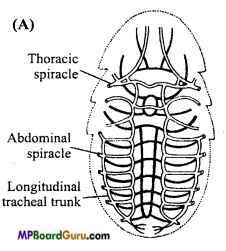
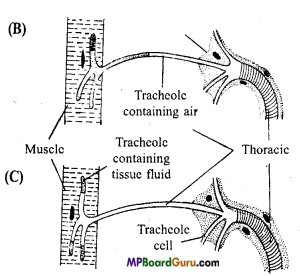
Fig. (A) Insect tracheal system (Dorsal tracheae white, ventral trachea black); (B) Tracheole at resting stage; (C) Tracheole at active stage These tracheal tubes opens out by paired lateral apertures called spiracles or stigmata in the body wall. The stigmata lead into wider atrium. Each trachea branches extensively to form tracheoles. These fine tracheoles end blindly intracellularly in the tissue cells.
The tissue fluid can diffuses into the tracheoles and the oxygen present in the air in tracheoles gets dissolved in it directly and hence into the cells. The blood of cockroach is called haemolymph. It is colourless and does not contain any respiratory pigment, thus O2 comes directly into tissue cells through trachea.
When the insects is at rest, it has low oxygen requirement. This is met without much effort from the oxygen dissolved in tissue fluid which has diffused into tracheoles. When the insect is moving or flying, it has high oxygen requirement. To meet this, respiratory movements take place. They involve alternate relaxation and contraction. The former draws fresh air into the tracheal system through the spiracles (inspiration) while the later expels air (expiration). In such situation, fluid is withdrawn from the tracheoles into the cells and the air goes deep into the tracheoles and reaches the cells directly.
Question 8.
Explain the following respiratory organs with suitable diagrams:
(1) Larynx,
(2) Trachea,
(3) Bronchi,
(4) Lungs.
Answer:
The respiratory system of mammals, chiefly made up of larynx, trachea, bronchi and lungs.
1. Larynx: It is situated in neck on the level of fourth to sixth cervical vertebrae. The larynx is formed with the help of various cartilages thyroid, cricoid, paired arytenoid and epiglottis out of these thyroid cartilage is the largest. Epiglottis is situated behind the tongue. Its main function is to cover the entrance of the larynx so that food may not enter it during swallowing. The larynx is lined with numerous membrane covered with ciliated epithelium. When air is passed through it sound is produced.
2. Trachea: The larynx at the level of the seventh cervical vertebra joins the trachea which is a tube about 12 cm long. It is supported by half rings of cartilages which are articulated with the help of ligaments. The trachea is internally lined with mucous membrane. Externally it is covered by connecting tissue membrane. Trachea enters the thoracic cavity. At the level of fourth or fifth vertebra it bifurcates into bronchi.
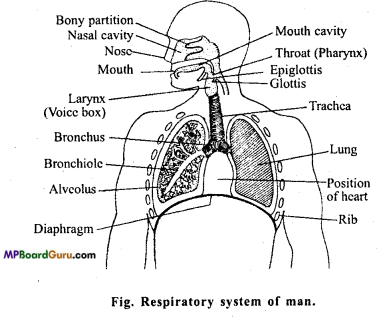
3. Bronchi: The two bronchi, right and left, are termed as primary bronchi. These enter the lung from their own side. Each after entering the lung divides into smaller branches, which ultimately profusely branch in the surface of lung. The structure of these smaller branches called bronchiole is the same as that of trachea.
4. Lungs: The lungs are two in number, situated in the thoracic cavity. They are dark red coloured, spongy bag like structures. Each lung is distinguished into three surfaces i.e., coastal, spongy, bag-like structures. Each lung is mediastinal surface, a groove is present through which bronchi, pulmonary nerves, pulmonary artery, veins and lymph vessels enter. All these structures are bound together by a connective tissue, into a bundle called root of the lung.
Breathing and Exchange of Gases Class 11 Important Questions Objective Type
1. Choose the correct answers:
Question 1.
In cellular respiration breakdown of glucose into C02 and HzO takes place in:
(a) Nucleus
(b) Cytoplasm
(c) Mitochondria
(d) Lysosome.
Answer:
(c) Mitochondria
Question 2.
Rate of respiration will be lower during :
(a) Playing
(b) Sleeping
(c) Eating
(d) Speaking.
Answer:
(b) Sleeping
![]()
Question 3.
Bicarbonate ions can be generated in :
(a) Lymphocytes
(b) Neutrophil
(c) Basophil
(d) R.B.Cs.
Answer:
(d) R.B.Cs.
Question 4.
The blood of animal is light blue in colour due to the presence of:
(a) Cytochrome
(b) Haemoglobin
(c) Haemocyanin
(d) Cobalt.
Answer:
(c) Haemocyanin
Question 5.
The conductor of O2 or respiratory pigment of vertebrates is :
(a) Haemocyanin
(b) Chloroquine
(c) Haemoglobin
(d) Haematin.
Answer:
(c) Haemoglobin
![]()
Question 6.
Which of the following is capable of carrying O2 :
(a) Lymph
(b) Serum
(c) Blood
(d) Plasma.
Answer:
(c) Blood
Question 7.
The causes of sudden and deep expiration is :
(a) Increase of CO2 concentration in blood
(b) Increase in the concentration ofO2
(c) Decrease in the concentration of CO2
(d) Increase in the concentration of O2 and decrease in the concentration of CO2 in blood.
Answer:
(a) Increase of CO2 concentration in blood
Question 8.
After inspiration diaphragm becomes :
(a) Relaxed
(b) Constricted
(c) Expanded
(d) Remain intact.
Answer:
(b) Constricted
Question 9.
The process of respiration is regulated by :
(a) Central nervous system
(b) Lungs
(c) Trachea
(d) Peripheral nervous system.
Answer:
(a) Central nervous system
Question 10.
Invertebrates O2 is conducted :
(a) After absorption on the surface of R.B.Cs.
(b) Through the formation of a complex with Hb
(c) Through plasma
(d) All of these.
Answer:
(d) All of these.
![]()
Question 11.
ATP is:
(a) Enzyme
(b) Protein
(c) Hormone
(d) High energy molecule.
Answer:
(d) High energy molecule.
Question 12.
The lobes formed in right and left lungs of man :
(a) 3 and 2
(b) 2 and 3
(c) 3 and 3
(d) 2 and 2.
Answer:
(a) 3 and 2
Question 13.
Decomposition of oxyhaemoglobin into oxygen and deoxyhaemoglobin is due to :
(a) The reduction of oxygen pressure in tissue
(b) Increase in the pressure of oxygen
(c) Same pressure inside and outside the cell
(d) None.
Answer:
(a) The reduction of oxygen pressure in tissue
Question 14.
The exchange of gases in alveoli due to :
(a) Osmosis
(b) Simple diffusion
(c) Transport
(d) Active transport.
Answer:
(b) Simple diffusion
Question 15.
In the red blood cells of Mammals there is no gaseous exchange due to the absence of:
(a) Haemoglobin
(b) Nucleus
(c) Mitochondria
(d) None.
Answer:
(c) Mitochondria
![]()
Question 16.
The poisonous effect of carbon monoxide is due to its bondage with the haemo-globin. How much more its bondage with CO2 as compared to oxygen :
(a) Two times
(b) Twenty times
(c) 200 times
(d) 1000 times.
Answer:
(c) 200 times
Question 17.
The capacity of air for lungs of human is:
(a) 3000 ml
(b) 1500 ml
(c) 1000 ml
(d) 500 ml.
Answer:
(a) 3000 ml
Question 18.
Respiratory centre is situated in:
(a) Medulla oblongata
(b) Central part
(c) Front brain
(d) None.
Answer:
(a) Medulla oblongata
Question 19.
Respiration process occurs in the:
(a) Alveoli of the lungs
(b) Cells of the alimentary canal
(c) Cells of the brain
(d) In all cells of the body.
Answer:
(d) In all cells of the body.
Question 20.
Outer membrane covering of the lungs. is:
(a) Pleural membrane
(b) Pericardium
(c) Pentonium membrane
(d) Mucous membrane.
Answer:
(a) Pleural membrane
2. Fill in the blanks:
1. Lungs are situated in …………………….. .
Answer:
Thoracic cavity,
2. In insects respiration takes place by …………………….. whereas in prawn respiration takes place by ……………………..
Answer:
Spiracles, gills,
3. …………………….. pigment formed in RBCs.
Answer:
Haemoglobin,
4. …………………….. disease is caused due to smoking.
Answer:
Ephysema,
5. The respiratory organs of fishes are …………………….. .
Answer:
Gills,
6. In blood corpuscles, CO2 transport takes place in the form of …………………….. .
Answer:
Bicarbonate,
7. Krebs cycle takes place in …………………….. of cell.
Answer:
Mitochondria,
8. Yeast fermentation results in the formation of …………………….. and …………………….. .
Answer:
C2H5OH and CO2
9. Lungs are situated in …………………….. cavity.
Answer:
Pulmonary cavity,
10. The partial oxidation of glucose takes place in …………………….. respiration.
Answer:
Anaerobic.
3. Match the following:
(A)
| Column ‘A’ | Column ‘B’ |
| 1. Glycolysis | (a) PPP |
| 2. Krebs cycle | (b) Mitochondria |
| 3. Cristae | (c) Krebs cycle |
| 4. 30 ATP | (d) CO2, ATP |
| 5. 36ATP | (e) Pyruvic acid. |
Answer:
1. (e) Pyruvic acid.
2. (d) CO2, ATP
3. (b) Mitochondria
4. (c) Krebs cycle
5. (a) PPP.
![]()
(B)
| Column ‘A’ | Column ‘B’ |
| 1. Cockroach | (a) Cutaneous respiration |
| 2. Starfish | (b) Trachea |
| 3. Neris | (c) Parapodia |
| 4. Earthworm | (d) Water vascular system |
| 5. Insect | (e) Tracheole. |
Answer:
1. (b) Trachea
2. (d) Water vascular system
3. (c) Parapodia
4. (a) Cutaneous respiration
5. (e) Tracheole.
4. Answer in one word:
1. What is the breathing rate of man?
Answer:
16-20 per minute,
2. What is the number and area of the alveoli in human lungs?
Answer:
7,50,000,000 alveoli and 100 sq. meter,
3. Name the respiratory organ of fish.
Answer:
Gills,
4. Name the respiratory organs of leech and insects.
Answer:
Skin, tracheal system,
5. Which part of the body of Hydra takes part in gaseous exchange?
Answer:
Ectoderm,
6. What term is used for deficiency of O2 in body?
Answer:
Hypoxia,
7. Pigment help for transport of oxygen.
Answer:
Haemoglobin,
8. Which part of the brain regulate respiration process?
Answer:
Medulla oblongata,
9. Name the main respiratory organ of human where gaseous exchange occurs.
Answer:
Lungs,
10. Volume of the gas normally inhaled and exhaled by the lungs in human.
Answer:
Tidal volume.